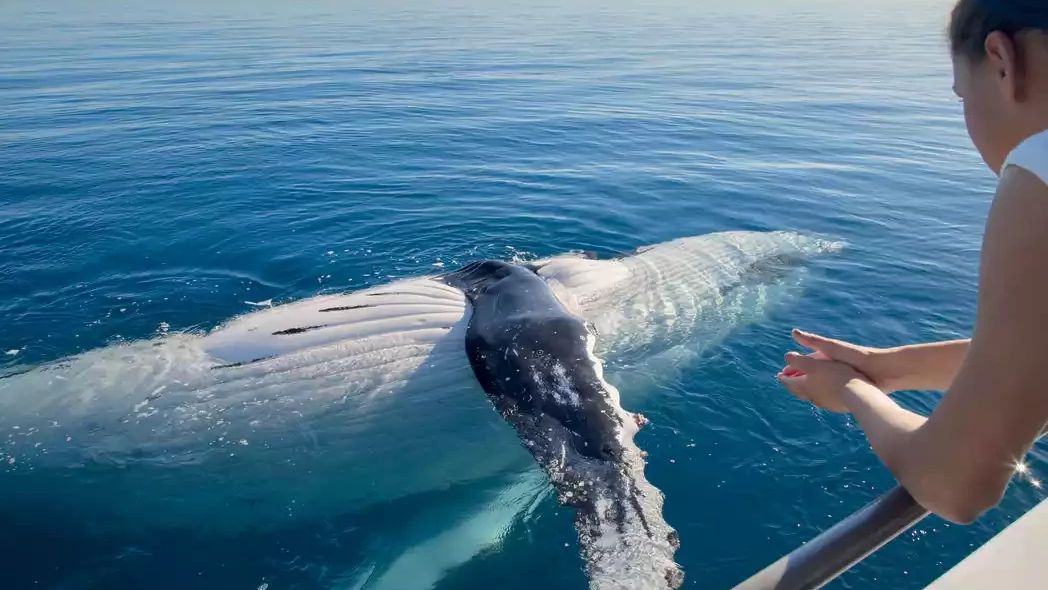The Best Time of Year to See Whales in Australia
Migration patterns of Australian whales
Each year, more than 40,000 humpback whales migrate along the eastern and western coasts of Australia, traveling from the cold Antarctic waters to the warmer breeding grounds in Queensland and Western Australia. This journey begins in May and continues through November, with peak sightings occurring from June to August. These months are considered the prime season for whale watching in Australia due to the high frequency of sightings and calm weather conditions.
Seasonal hotspots along the coast
From Hervey Bay in Queensland to Albany in Western Australia, the migration route provides multiple viewing opportunities. Hervey Bay, often called the whale-watching capital of Australia, sees thousands of whales between July and October. In New South Wales, Byron Bay and Jervis Bay also report increased sightings during this same period, offering ideal conditions for both boat and land-based watching.
Weather conditions and ocean visibility
The Australian winter (June–August) typically offers clear skies and relatively calm seas, especially along the sheltered bays. This results in optimal visibility for whale watchers. Visibility rates of up to 20 meters underwater have been recorded, aiding in underwater photography and clearer sightings from glass-bottom boats.
Impact of climate on whale movement
Recent studies from the Australian Marine Mammal Centre have indicated that changing sea temperatures may be slightly altering the timing of whale migrations. Warmer waters are encouraging some humpback pods to begin their journey as early as April. However, the overall peak remains within the winter months, maintaining consistency for tourism planning.
Economic impact during peak months
The Australian whale-watching industry generates approximately AUD 31 million annually, with over 1.6 million participants, according to the International Fund for Animal Welfare. A large portion of this activity occurs during the winter migration peak, contributing significantly to regional economies, particularly in coastal towns like Eden and Victor Harbor. Whale watching in Australia during these months provides both ecological and economic benefits.
Top Destinations for Whale Watching Adventures
Hervey Bay, Queensland
Known globally as a whale nursery, Hervey Bay offers one of the most intimate whale encounters. The shallow, protected waters attract mothers and calves from July to October. According to Queensland Tourism, over 75,000 people visited Hervey Bay for whale tours in 2022, contributing AUD 20 million to the local economy.
Albany, Western Australia
Albany’s King George Sound is one of the earliest recorded whaling sites in Australia. Now a sanctuary, this bay hosts southern right whales from June to October. Whale watching in Australia often starts early here due to the southern location. Boat tours report a 95% sighting rate during peak months, according to Western Australia Parks and Wildlife.
Sydney, New South Wales
Sydney offers unique urban whale watching opportunities. Between May and November, over 20,000 humpback whales pass by Sydney’s coastline. Tours depart from Circular Quay, and strategic lookouts such as North Head and Cape Solander are popular. In 2023, over 150,000 people participated in Sydney whale tours, according to Destination NSW.
Victor Harbor, South Australia
From June to September, Victor Harbor becomes a haven for southern right whales. The South Australian Whale Centre reports that up to 30 whales can be spotted close to shore during peak season. The nearby Bluff and Granite Island offer excellent vantage points for land-based observers.
Great Australian Bight, South Australia
The cliffs of the Great Australian Bight provide one of the most dramatic whale watching backdrops. Between May and October, southern right whales congregate here to give birth. The Head of Bight Whale Watching Centre estimates that over 1,000 whales are seen annually. Whale watching in Australia wouldn’t be complete without visiting this pristine, remote destination.
Whale Species You Can Spot Along the Australian Coast
Humpback whales
Humpbacks are the most frequently observed species along both the east and west coasts. These whales can grow up to 16 meters and weigh around 30,000 kg. Their acrobatic breaches and tail slaps make them a favorite among tourists. In 2023, over 35,000 humpbacks were recorded migrating along the east coast, according to the Australian Marine Mammal Centre.
Southern right whales
These massive creatures, weighing up to 80,000 kg, migrate primarily to the southern Australian coasts. Easily identifiable by their callosities and lack of dorsal fin, southern right whales frequent bays like Warrnambool and Head of Bight. Around 3,500 individuals are part of the Australian population, showing a slow but steady recovery since the end of whaling.
Minke whales
Although more elusive, minke whales are occasionally spotted in the Great Barrier Reef and around Sydney. Measuring up to 10 meters, their speed and smaller size make them more difficult to observe. Still, whale watching in Australia sometimes surprises visitors with minke encounters, particularly in July and August.
Blue whales
The largest animal on Earth, the blue whale, can be seen off the coast of Victoria and Western Australia, especially near Portland and the Perth Canyon. These whales can exceed 30 meters in length. Although rare, sightings have been increasing, with marine biologists recording up to 50 individuals near Perth in 2023.
Orcas and other species
The Bremer Bay Canyon in Western Australia is known for its seasonal orca gatherings. From January to April, tourists can witness groups of orcas hunting in coordinated pods. This makes Bremer Bay a unique addition to the whale watching in Australia experience, even outside the typical winter months.
Land-Based vs. Boat Tours: Choosing Your Experience
Advantages of land-based whale watching
Land-based observation points like Cape Byron, The Bluff, and Logans Beach offer free access and no seasickness. Many of these lookouts are elevated, providing panoramic views of the ocean. In Hervey Bay and Albany, 80% of visitors report satisfying whale sightings from shore, according to Tourism Research Australia.
Advantages of boat-based tours
Boat tours provide up-close encounters, often within 100 meters of the whales. Modern vessels are equipped with hydrophones and underwater viewing windows. Tour operators like Spirit of Hervey Bay boast a 98% sighting rate during peak season. Whale watching in Australia by boat often results in unforgettable moments, like witnessing a whale breach just meters away.
Costs and accessibility
Land-based options are often free, with only parking or minor entry fees. In contrast, boat tours range from AUD 70 to AUD 150 per adult, depending on the location and duration. Tours in premium destinations like Sydney or Hervey Bay may also include food, guides, and guarantees of another trip if no whales are seen.
Environmental considerations
Boat operators must adhere to strict environmental regulations, maintaining at least a 100-meter distance from adult whales and 300 meters from calves. Land-based viewing has no environmental impact, making it a preferred choice for eco-conscious tourists. Whale watching in Australia remains one of the most responsibly managed wildlife activities globally.
Tour preferences by demographics
According to a 2022 report by Ecotourism Australia, families and older tourists tend to prefer land-based options, while younger adventure-seekers opt for boat tours. Accessibility features such as ramps and viewing platforms make many land-based locations suitable for all ages and abilities.
Indigenous Stories and Cultural Connections to Whales
Whales in Aboriginal mythology
In many Aboriginal cultures, whales are seen as spiritual ancestors or totemic beings. In the Yuin Nation of New South Wales, whales are believed to carry the souls of the departed. Ceremonies are often held during migration seasons to honor these beings. The cultural layer adds spiritual depth to whale watching in Australia.
Traditional hunting and respect
While commercial whaling is now banned, historical records show that coastal Aboriginal groups engaged in sustainable whale harvesting from stranded whales. This was done with reverence and ritual, unlike the industrial exploitation by European settlers. These practices reflect a symbiotic relationship between humans and whales.
Contemporary Indigenous tourism
Tours such as those operated by Ngaran Ngaran Culture Awareness in New South Wales integrate whale watching with Dreamtime storytelling and bushwalks. Participants not only observe marine life but also engage with Indigenous traditions and land care ethics. This holistic experience is redefining whale watching in Australia for many travelers.
Whale songs and spiritual connections
Whale songs are considered by some Aboriginal groups as messages from the ancestors. These low-frequency vocalizations travel hundreds of kilometers and are interpreted in rituals and dances. Recent collaborations between scientists and Indigenous elders have explored parallels between acoustic data and oral traditions.
Role in land and sea management
Indigenous Rangers programs, such as those funded by the Australian Government, involve Aboriginal communities in marine monitoring and conservation. These programs help protect key whale habitats while respecting cultural knowledge. They represent a modern synergy between science and tradition in the context of whale watching in Australia.
Tips for Ethical and Responsible Whale Watching
Understanding marine life behavior
Whales may breach, slap, or dive as part of natural behaviors or communication. It is crucial to observe these behaviors without interference. Avoid making loud noises or throwing objects into the water. Being informed enhances the whale watching in Australia experience while minimizing stress on the animals.
Choosing certified tour operators
Select operators accredited by Ecotourism Australia or licensed under state marine regulations. These operators follow guidelines for safe distances and engine speeds. In 2023, over 85% of whale tour companies in Queensland were certified, according to Marine Tourism Australia.
Following distance and speed regulations
By law, vessels must stay at least 100 meters from adult whales and reduce speed to under 6 knots. Swimmers and divers must stay at least 300 meters away. Failure to comply can result in fines up to AUD 12,000. These rules ensure a sustainable future for whale watching in Australia.
Respecting wildlife zones and signage
Many whale hotspots have designated viewing platforms and marine parks with clear signage. Stick to marked trails and do not trespass on protected dune ecosystems. In 2022, Parks Victoria issued 57 warnings to individuals violating protected zone rules, emphasizing the importance of awareness.
Minimizing waste and plastic use
Tourists are encouraged to bring reusable water bottles and avoid single-use plastics. Marine debris remains one of the top threats to whale health, with over 70% of stranded whales in NSW found with plastic in their stomachs, according to a 2021 CSIRO report. Responsible tourism helps safeguard these majestic creatures.
What to Pack for a Memorable Whale Watching Trip
Clothing for different climates
Depending on the season and location, temperatures can vary widely. In Hervey Bay during July, average daytime temperatures are around 22°C but can drop to 10°C on the water. Windproof jackets, layered clothing, and hats are essential for comfort during whale watching in Australia.
Essential gear for viewing and photography
Binoculars with at least 8x magnification help spot distant whales. DSLR or mirrorless cameras with telephoto lenses (200mm or longer) are recommended. Smartphones with stabilizers or zoom attachments can also work well. Tripods or monopods add stability on rocking boats.
Snacks, hydration, and motion sickness prevention
Pack high-energy snacks like granola bars and fruit, and bring at least one liter of water per person. Motion sickness tablets or bands are advisable, especially for first-time boaters. In a 2023 survey, 40% of whale watching participants reported mild seasickness, emphasizing the need for preparation.
Tech tools and wildlife guides
Apps like “WhaleTrack” or “MarineWatch” provide live sighting updates. Laminated whale ID charts are useful for identifying species. Many tours also provide hydrophones for listening to whale songs. These tools enhance the educational value of whale watching in Australia.
Eco-conscious travel items
Opt for reef-safe sunscreen, biodegradable wipes, and reusable containers. Avoid glitter or cosmetics that may wash off into the ocean. Supporting local eco-friendly brands also contributes to conservation. Packing sustainably aligns your experience with the ethics of marine protection.




